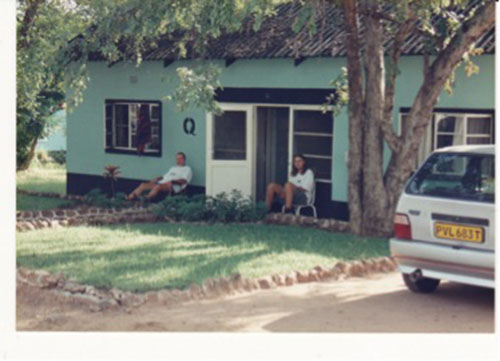Life in Rhodesia: part two

This is part two of Lindy’s life in Rhodesia. To read her previous instalments, click here.
One of the beautiful places to holiday is Victoria Falls. We holidayed there just before coming to Australia. The local people call it “The smoke that thunders”. This is one of the Seven Wonders of the World. Victoria Falls lays almost directly half way along the Zambezi River in its 1677 mile stretch from its source to the sea. The Zambezi River flows through Zambia, Angola, Namibia, Botswana, Zimbabwe and Mozambique. The Falls are approximately 5577 feet wide and are one and a half times wider than Niagara Falls.
This is the Victoria Falls Hotel.
We sat on the other-side of the gorge and watched everyone bungy jump into the gorge. It is not something that any of my family tried.
This is how much mist the falls make. Every time we went to sightsee we got soaked. It really is not a problem as it is very hot and humid there.
All around Victoria Falls the African women sit on rocks or whatever is available to sit on, and crochet all day. They make the most beautiful table cloths and little cloths for the small tables. And they just love to bargain the price on stuff. At this same place the men carve animals out of soap stone.
The statue of David Livingstone is placed at the entrance to Victoria Falls.
This is the cabin we stayed in and while we were unpacking the food and stuff from the car and placing it in the kitchen the monkeys would climb in the kitchen window and pinch the bread and groceries. These monkeys were not at all afraid of humans. They had got so used to visitors and knew that they could get fed.

Another place we used to go camping with the family was Kariba Dam. This is a hydroelectric dam in the Kariba Gorge of the Zambezi River basin. It is one of the largest dams in the world standing 128 metres (420 feet) tall and 579 metres long.
The double curvature concrete arch dam was constructed between 1955 and 1959 at a cost of $135,000,000. It was eventually finished in 1977 and the total cost was $480,000,000. Eight-six lives were lost in the building of this dam.
The gorge at Kariba Dam.
The dam is full of hippos and they have been known to tip up the small fishing boats. More people have been killed by hippos than any other wild animal. The fishing in the dam was great and the tiger fish were plenty. One down-side to Kariba was the amount of mosquitoes. We had to sleep under nets to get some peace. Also, the mozzies can give you malaria and that makes you very sick.
 This is one of the tiger fish that we caught at Kariba. We were not so lucky to catch such a beauty.
This is one of the tiger fish that we caught at Kariba. We were not so lucky to catch such a beauty.
Above is our bungalow in Kariba.
In these two photos you can see the hippo coming up to the top.
An aerial view of the Kariba dam being built.
Our next stop was Operation Noah, a wildlife rescue operation in Rhodesia lasting from 1958 to 1964, caused by the creation of Lake Kariba on the Zambezi by the Kariba Dam. In the late 1950s, North and South Rhodesia (present-day Zambia and Zimbabwe) became home to the world’s largest man-made dam – home to thousands of native animals. In a wildlife rescue operation lasting 5 years, over 6000 animals were rescued and relocated to the mainland.
The operation was led by Rupert Fothergill. Over 6,000 animals (elephant, antelope, rhino, lion, leopard, zebra, warthog, small birds and even snakes) were rescued.
Elephants would also walk around at night and were not really concerned with all the campers. There is nothing like sitting round the campfire at night and listening to all the wild life.
At Wankie National Park we had the most amazing time and managed to see quite a bit of wildlife.
This picture of the lion was taken from our car. The lion was only about three feet from us. Fortunately, she had just eaten and was not interested in us. All she wanted to do was sleep off the meal.
The photo above shows a kudu wandering around.
This is a picture of the chalet we stayed in while there. At night the wildebeest just wandered casually around the campsite. They were so used to people that they just came quite close to the chalet. While we were eating dinner at the restaurant the wildebeest would just stand and watch what was going on. Then on the walk back to the chalet we had to use a torch so that we did not bump into any animals.
Have you explored through wildlife? What animals have you encountered? Tell us below!





















 Proudly Australian owned and operated
Proudly Australian owned and operated